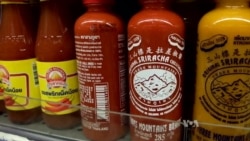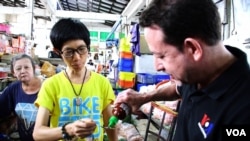With sales exceeding $80 million annually, Huy Fong Food’s Sriracha brand has made a coastal Thai city a household name in America and propelled an Asian chili sauce to a condiment nearly as ubiquitous as ketchup.
Sriracha sauce now flavors numerous other American-made products from popcorn to beer. It is lauded in songs and the sauce has spawned several cookbooks — all the more remarkable considering Huy Fong Foods has never advertised.
American made spicy sauce
Made with red jalapeño peppers exclusively from a farm encompassing more than 800 hectares (2,000 acres) in adjacent Southern California counties, Huy Fong’s Sriracha is hot on the tail of America’s traditional best-selling spicy sauce, Tabasco.
Tabasco, a nearly 150-year old Cajun-style vinegary pepper sauce, is spicier (on the Scoville scale as tested by the American Chemical Society) and about five times as expensive as Huy Fong’s Sriracha, created by David Tran, an ethnic Chinese from Vietnam who immigrated to California.
The Louisiana-based McIlhenny Company, maker of Tabasco, has begun marketing its “Premium Sriracha Sauce” while other mass market imitators and boutique brands in the United States also sell their own Sriracha sauces.
Tran, a major in the South Vietnamese army, created his first hot sauce in 1975, the year his country fell to the Communist North.
Hand bottling a new sauce five years later for restaurants in Los Angeles’ Chinatown, Tran co-opted but did not copyright the Sriracha name, a variation of the spelling of the Thai town of Si Racha.
In the seaside community on the east coast of the Gulf of Thailand, famed for its seafood dipping sauce, Thais can be disillusioned if confronted with a “Sriracha” sauce manufactured 13,000 kilometers away.
“What do you mean it’s from America? Its name is Sriracha,” exclaimed Booncherd Nilsonthi, a uniformed Si Racha municipal government officer when shown the American sauce in the green-capped red bottle emblazoned with a white rooster.
Food writer Wanvida Jiralertpaiboon of ipick.com agreed, saying, “because of the name it’s obvious that it should be from Thailand.”
And how does it translate on local tongues?
“This American one is way saltier and spicier. But the Thai sauce is more sweet and sour,” commented Nida Khajonrungruang, a purveyor of hot sauces in Si Racha’s central food market. “However, Si Racha [sauce] has to be produced in Si Racha.”
American versus Thai
Her adult daughter, Aree, who also sampled the California concoction brought to the market by VOA, compared it to ketchup, speculating it is a better match for the meaty dishes preferred by foreigners, such as steaks, than the Thai original.
Thais, she explained, prefer a thinner sauce to eat with their typical dry noodle dishes.
“Both are good,” but the American variety is “too hot,” Aree concluded.
An owner-cook of the small, outdoor Nong Pim restaurant near the city’s jetty was having none of it. Her face did not reflect enjoyment when sampling the Sriracha sauce from abroad.
“I prefer our traditional Thai sauce as its flavor is more mellow, well rounded and smooth,” declared Matcharee Kedpathum. “The American one has some flavor, but it’s sharp, strong and not well rounded.”
Thai brands, relying on roasted chilis, tend to use more salt than sugar for their “Si Racha” sauces while Tran’s California recipe lists sugar as the number two ingredient behind ground chilis.
There are several dueling claimants in Thailand to the origins of the original Si Racha sauce. Its creation is attributed to different people circa 1930, including a Thai woman and Burmese immigrant sawmill workers.
“Some of my acquaintances conducted research about the sauce’s history, but they could not prove its origin,” Matcharee told VOA.
But one thing on which discerning palates in Si Rachi agree — the foreign upstart – widely known among Americans as “the rooster sauce” due to its cock logo and hard-to-pronounce name — has flown off in a different culinary direction.













